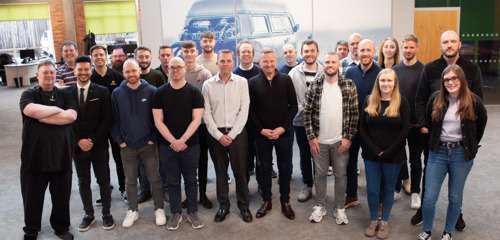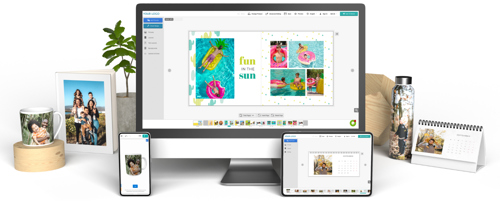The 1990s and early 2000s had seen the introduction of digital colour presses that could handle short runs and single copies, then short-run book binding equipment was developed to give attractively finished hard- and soft-cover books in all sorts of sizes and shapes.
The idea of web-to-print for ‘event’ photobooks was around from the start. However, most consumers couldn’t upload big picture files until the advent of domestic broadband in the early 2000s. Around the same time, digital cameras hit the consumer and professional markets, giving ready-digitised images without the hassle and expense of film development and scanning. Smartphones with rapidly improving cameras plus ever-faster internet access for picture uploading, accelerated the trend.
It all came together in the mid-to-late 2000s, when Taopix came on the scene. James Gray was the founder in 2007 and remains CEO today. He had previously been distributing software solutions for printers, including web-to-print, when his clients complained about the lack of easy-to-use wedding album software.
This set the wheels in motion for what became Taopix. Gray says he came up with the name while he was travelling – Tao means a road, path or ‘the way to’. Pix can be read as pixel or pics.
There are other team members who have been there since the beginning too, including Kevin Gale who today is chief technology officer.
“Taopix was established by people were looking for a solution which did not yet exist; the ability to create meaningful and high-quality photobooks, at home,” says Michael Carey, commercial director. “The technology quickly advanced to include personalised calendars, greetings cards and gifts.” Carey has been with Taopix for 10 years, starting as business development manager and becoming a director in 2021.
Gray is also an investor and advisor with Transeomedia, Taopix’s UK distributor led by Neil Bather, that has worked hard to establish the brand since 2009. “Transeomedia essentially acts as our UK sales department,” says Bather. “We also have licensed distributors throughout Europe and Asia.”
What does Taopix produce?
Taopix is a white-label personalisation software system, available in a desktop, online only or desktop and online format. This is rebranded to fit a business’ guidelines, allowing the end-customers to create their own gifts or photobooks without knowing a third party is involved. The creation software is locked into the service provider, so jobs can only be uploaded there.
“We provide a dynamic platform that not only affords creative freedom for the end-user, but also offers a whole host of behind-the-scenes solutions for the retailer,” says Carey. “These solutions include automated workflows, various APIs including Shopify for easy installation and many more designed to make business run smoother for the retailer.
“We offer a bespoke solution, with pricing models which vary dependent upon the wants of the prospect. Additions such as AI photobook functionality, numbers of products available and the number of brands associated are all examples of what can be tailored to create a solution.”
The creation software will work on most screen sizes. “Many end-users choose to create their projects entirely on their mobile or tablet devices,” Carey says.
Taopix Online means that the end-user only needs an internet connection to upload images and create projects. However, Taopix Desktop uses a downloadable app, and can work offline after that until the time comes to upload the completed project.
The design stage offers picture import and placement, with facilities for adding captions and larger text blocks. There are snap-to-grids to aid alignment, and the option to place pictures automatically throughout a multi-page book. 
Users and their customers can access a large range of free assets, fonts and layouts. “Our in-house designers create these new items, adding them to our Launch Pack,” says Carey.
“Businesses can also import their own background designs into Taopix made from whichever software they prefer. Our design team is also available for commission, creating new designs and layouts to fit a brief discussed with the customer.”
The new AI Smart Designer function will automatically select the best photos in a set, detect faces, retain chronological order and create micro stories, which are then intelligently positioned in the book. “This dramatically reduces the time needed to create a product – which, in turn, leads to a higher conversion rate for our customers,” says Carey. “AI Smart Designer makes it easier for an end-user to complete their project.”
There’s also support for 3D objects, with jigsaws, pet tags, mugs and tote bags being popular choices. “When an end-user is creating a 3D product, their designs are made on a flat rendering of the printable space,” says Carey. “They will then have a preview window which allows them to see how their project will wrap around the item when 3D. Taopix has a huge library of 3D models and also welcomes customers uploading their own.”
A new “revolutionary” offering is QR Scan Image Uploader, allowing uploading of images from multiple devices, or collaboration with friends on a project. Carey explains “All the user needs to do is scan the QR code through their device’s own camera app and click the link to upload. Users can share this upload portal with friends and family, just by sharing the link with them.”
Who are the customers?
“Our most common customer profile is digital printers with an established business already, who are adding personalised products as an additional asset,” says Carey. “We do, however, have customers of all kinds – from families working out of their garages with no prior print experience to multimillion-pound enterprises. With our tailored approach, we have solutions to businesses of all scales.”
New customers are offered training that fits their schedules and isn’t limited on numbers of staff. It’s usually delivered remotely, though Carey says that Taopix will travel to deliver masterclasses.
Where it’s at
The company is based in Ponteland, a small town to the north west of Newcastle upon Tyne. “We operate from a spacious, open-plan office which allows for easy and natural collaboration between teams,” says Carey. “Our office has played host to visitors from across the globe; customers and distributors have all visited the site for various events, such as a user conference.”
Until 2016 Taopix was based in a smaller unit across the road from the present one, he says. “When moving sites, it was important to stay as close to our previous office as possible for easy team commutes, local business relationships and the benefit of being a 10-minute drive from Newcastle International Airport, which is a huge bonus as a business which facilitates so much international travel.”
The company employs around 30 people, Carey says. “We are based in our HQ, with exception of three regional business development managers in London, Amsterdam and Mexico.” These managers, and Gray, travel regularly and extensively to meet customers and prospects within their sales territories, as well as attending international trade shows.
“Taopix is mostly comprised of our R&D team, who develop our technology entirely in-house. We’re a self-resourcing company, with our own finance, admin, support, marketing and design departments. Fulfilling all our needs in-house means that we can readily offer professional services to our customers, such as e-commerce management packages, as we have the team, experience and knowledge available.”
Covid naturally had an impact, though the lockdowns also had some benefit for Taopix and its users, Carey says. “We found ourselves, through not only luck but the hard work of our team, able to flourish in the height of Covid-19. It seemed that with so much of the world being tucked safely in their homes, people had the time to create photobooks. With so many people feeling a loss of community, the demand for personalised gifts and cards also skyrocketed as people were looking to deepen personal connections when they couldn’t physically be present.”
Taopix established itself and continues to flourish in a sector where some others fell by the wayside. “One determiner in our early success was that we also built Taopix around the needs of the PSPs,” Carey explains. “Whether they wanted to sell B2C, B2B, or B2B2C, Taopix had all the white-labelling tools businesses needed to maximise their growth. We also built our platform to be multilingual, and have the exact same user experience on a Mac or PC. We also understood the printing world, and supplying reliable, print-ready files every time on a stable and robust platform was always key. Of course the end-user experience is critical too.”
What’s next?
This is going to be an exciting year for Taopix, with major new developments on the way. “We have recently released a new iteration of Taopix Desktop, in December 2023,” says Carey. “We also have some very exciting news which is soon to be released!”










